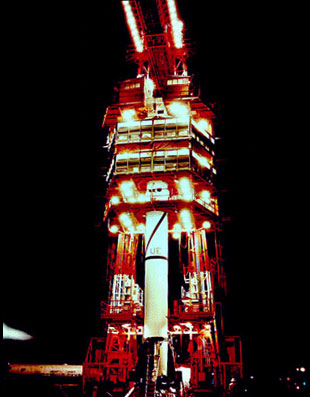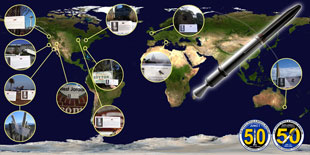January 31, 2008 — Fifty years ago today, the 70-foot Juno 1 rocket, a modified Redstone missile, launched the 30 pound, 7-foot Explorer I satellite, marking the first U.S. built payload to enter Earth orbit. Three of the booster's four stages fell into the ocean while the fourth, which was used to boost Explorer I's velocity, entered orbit behind the satellite.
Explorer I was the third man-made moon to circle Earth, following the Soviet Union's Sputnik I and II spacecraft. It was the second satellite with a payload, a small science package that was built to measure cosmic rays, which led to the detection of a radiation belt (the Van Allen belt, named after Dr. James van Allen, who designed and built the instrumentation).
Explorer I operated, sending back data to the ground, for just over 100 days before its batteries died, but it wasn't until March 31, 1970, 12 years and two months after its launch, did the satellite disintegrate while reentering the atmosphere.
It was around that time, if not a few years earlier, did the museum that was erected near where the historic mission had its start began distributing small pieces of the gantry that supported Juno I on the pad as it prepared to launch Explorer I.
"The beginnings of this are sort of lost in legend, if you will," explained James Banke, secretary of the U.S. Air Force Space & Missile Museum Foundation. "No one, and we've asked around a little bit, even among those who run the museum itself, no one is really sure when it began."
"I can tell you that when I vacationed in Florida from growing up in Minnesota, that when I visited the museum in 1970-1971, that practice was going on. I remember getting one of those cards," said Banke in an interview with collectSPACE.com.
The cards to which Banke refers present an "X" shaped piece of metal, sometimes with a residual coating of the launch gantry's red paint, attached alongside a photo of Juno I on the pad and a description of the history behind the small fragment. The title "Souvenir of America's First Satellite" stretches along the top of the cards.
"The material that is on there is from a mesh screen that used to cover and surround the elevator that was used to go up and down the gantry. That mesh was disposed of and one of the museum's volunteers thought, 'Hey, this might be good for fund raising,' and literally pulled it from the trash," recalled Banke. "We don't know who that was or when exactly he did that, but now, as we need to, we pull it back out and cut it into small little pieces to put on the cards."

Juno 1/Explorer I being prepared for launch at Complex 26 Pad A at the Cape Canaveral Air Force Station in Jan. 1958. (NASA) |
The remainder of the gantry that launched Explorer I still exists, though it is presently fenced off from the public at Cape Canaveral's Complex 26, Pad B. At Pad A, where Juno 1 lifted off on January 31, 1958, stands a Thor-Able rocket.
"The gantry has been completely pulled down. It just got to the point where it was too unsafe to be standing erect anymore," said Banke. "Pieces are lying on the ground."
The Foundation is considering its options with regards to restoring the gantry, but it is a matter of funding while balancing the needs of the other missiles and facilities under their care. There are no plans however, to use it to make more souvenir cards. When the mesh runs out, so will the cards.
"It is a limited supply," said Banke. "There are only a few of these little screens of material left.
"I imagine we will have enough to last a few more years."
Even when the museum runs out of souvenirs to give out, their legacy will continue on a truly global scale.
"If you wanted me to hazard a guess of how much money has been collected or how many of these pieces are out there, I couldn't even begin to tell you. It has to be in the thousands," estimates Banke.

Click above to launch interactive map. |
An informal poll conducted by collectSPACE.com of its readers quickly located more than 100 of the fragments in private collections worldwide. Card owners came forward from across the United States and spread to a number of European countries and even "down under" to Australia.
"The space program from day one has helped shrink the world in ways we never thought possible," Banke posed.
Don't have yours yet? No worries, says Banke, just come to the museum. They do not sell the cards but rather offer them in return for a donation of the visitor's choosing.
"We've heard stories that they are on sale on eBay for much, much more money, $30 to $40 a piece. Buyer beware I guess in the collectible world. All you have to do is come to Florida and we'll give you one for practically nothing," he offers.
"If you want one, all you have to do is come to the museum, put your dollar in and take one. We'd appreciate if you'd also sign your name to the log book of visitors."
